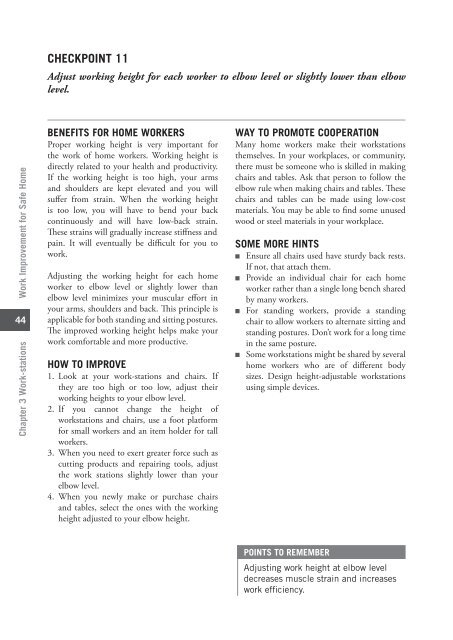Work Improvement for Safe Home - International Labour Organization
Work Improvement for Safe Home - International Labour Organization
Work Improvement for Safe Home - International Labour Organization
You also want an ePaper? Increase the reach of your titles
YUMPU automatically turns print PDFs into web optimized ePapers that Google loves.
<strong>Work</strong> <strong>Improvement</strong> <strong>for</strong> <strong>Safe</strong> <strong>Home</strong><br />
44<br />
Chapter 3 <strong>Work</strong>-stations<br />
CHECKPOINT 11<br />
Adjust working height <strong>for</strong> each worker to elbow level or slightly lower than elbow<br />
level.<br />
BENEFITS FOR HOME WORKERS<br />
Proper working height is very important <strong>for</strong><br />
the work of home workers. <strong>Work</strong>ing height is<br />
directly related to your health and productivity.<br />
If the working height is too high, your arms<br />
and shoulders are kept elevated and you will<br />
suff er from strain. When the working height<br />
is too low, you will have to bend your back<br />
continuously and will have low-back strain.<br />
Th ese strains will gradually increase stiff ness and<br />
pain. It will eventually be diffi cult <strong>for</strong> you to<br />
work.<br />
Adjusting the working height <strong>for</strong> each home<br />
worker to elbow level or slightly lower than<br />
elbow level minimizes your muscular eff ort in<br />
your arms, shoulders and back. Th is principle is<br />
applicable <strong>for</strong> both standing and sitting postures.<br />
Th e improved working height helps make your<br />
work com<strong>for</strong>table and more productive.<br />
HOW TO IMPROVE<br />
1. Look at your work-stations and chairs. If<br />
they are too high or too low, adjust their<br />
working heights to your elbow level.<br />
2. If you cannot change the height of<br />
workstations and chairs, use a foot plat<strong>for</strong>m<br />
<strong>for</strong> small workers and an item holder <strong>for</strong> tall<br />
workers.<br />
3. When you need to exert greater <strong>for</strong>ce such as<br />
cutting products and repairing tools, adjust<br />
the work stations slightly lower than your<br />
elbow level.<br />
4. When you newly make or purchase chairs<br />
and tables, select the ones with the working<br />
height adjusted to your elbow height.<br />
WAY TO PROMOTE COOPERATION<br />
Many home workers make their workstations<br />
themselves. In your workplaces, or community,<br />
there must be someone who is skilled in making<br />
chairs and tables. Ask that person to follow the<br />
elbow rule when making chairs and tables. Th ese<br />
chairs and tables can be made using low-cost<br />
materials. You may be able to fi nd some unused<br />
wood or steel materials in your workplace.<br />
SOME MORE HINTS<br />
■ Ensure all chairs used have sturdy back rests.<br />
If not, that attach them.<br />
■ Provide an individual chair <strong>for</strong> each home<br />
worker rather than a single long bench shared<br />
by many workers.<br />
■ For standing workers, provide a standing<br />
chair to allow workers to alternate sitting and<br />
standing postures. Don’t work <strong>for</strong> a long time<br />
in the same posture.<br />
■ Some workstations might be shared by several<br />
home workers who are of diff erent body<br />
sizes. Design height-adjustable workstations<br />
using simple devices.<br />
POINTS TO REMEMBER<br />
Adjusting work height at elbow level<br />
decreases muscle strain and increases<br />
work effi ciency.

















